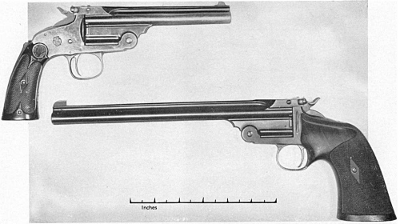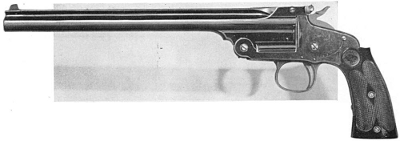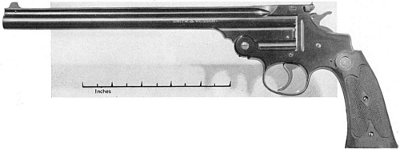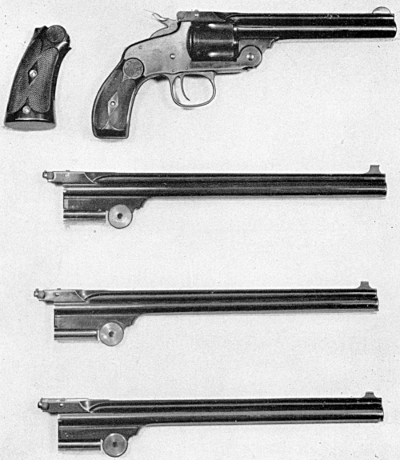The following information Smith & Wesson single shot target pistols comes from Smith & Wesson Hand Guns by Roy C. McHenry and Walter F. Roper. Smith & Wesson Hand Guns is also available to purchase in print.
Mention has been made before of a Smith & Wesson New Departure revolver in .32 caliber. This arm chambered the rather futile cartridge used in earlier center-fire revolvers of small size. It was capable of inflicting a mortal wound if the circumstances were propitious, but it was thoroughly inadequate for dealing with a determined hold-up man.
The first model .32 Safety Hammerless was simply a smaller model of the first .38. It was manufactured from February, 1888, until September, 1900, with serials from 1 to 91,417, with 3 or 3 3/1-inch barrel and a choice of nickel or blued finish.
A second model, differing only slightly from its predecessor and shooting the same cartridge, was put on the market in October of 1900. It could be had with a two-inch barrel in addition to the other lengths, and the amputated version was handy for hip-pocket carrying on bicycle trips. The barrel catch was T-shaped and joined into the barrel strap, while the release was placed at the locking post instead of some distance forward, as in the first model. Serial numbers on this model started at 91,418, where the other was discontinued, and by October of 1922 had reached 226,880. Both the .32 and .38 still are catalogued by the firm.
After failure to make a military arm out of their New Departure, Smith & Wesson decided to improve their .38 single-action. In 1891 they substituted a bow-trigger guard for the spur trigger and changed the shape of the hammer, giving it a flanged thumb piece fitted with a rebounding lock for greater safety. Half-cocking was not necessary, and the hammer did not have to be carried on an empty chamber. As in the 1880 model, the cylinder revolved freely when loaded but not cocked. With its six-inch barrel it made a splendid target shooting arm, as the .38 S&W cartridge is accurate and well balanced. From February, 1891, until some time in 1911, they produced 28,107 including about 7,000 of the so-called Mexican Model. This designation is said to have been used because the revolvers were destined for the Russian trade, which seems obscure, to say the least.

Smith & Wesson Single Shot, Model 1891, .22 Pistol with 10-inch barrel, fitted with Roper stocks.
The Mexican Model presented two variations. It had no bow-trigger guard or even an orthodox spur guard forming a part of the frame—as in the 1880—but a spur guard which was grafted to the frame. Also, the hammer had no half-cock notch, but this did not matter greatly in view of the rebounding hammer. Serial number of this model were included with the 1891 single-action .38.
Out of the conventional 1891 Model was developed something unusual. Someone at the Smith & Wesson plant with an ingenious mind and a talent for tools removed the barrel and cylinder from one of the guns and fashioned a single-shot barrel which was hinged to the frame. It extended through the space where the cylinder had been and joined solidly above to what was formerly the top strap. Below, it met a flat extension which covered the space of the lost cylinder. The extracting gear ran through the extension and was similar to that on the revolver, so that the result was a single-shot, top-break pistol.

Smith & Wesson records do not reveal the name of this longheaded inventive genius. Daniel Wesson himself probably was not the man, for the arms he fathered are all carefully recorded. Perhaps the name could be found by studying the plant payrolls of the period and discovering some workman who received a substantial raise just before the pistol was announced.
At any rate, the new single-shot quickly became a favorite with the firm and with target shooters. It had one defect as originally constructed. The grip (being made for a pocket revolver) was entirely too small to balance the rest of the weapon, so an oversize hard-rubber grip was designed to fasten over it.
The first stock single shots built along these lines were of six-inch barrel length and .38 caliber. Shortly afterward they were made also in .32 caliber. But the single shot experts, who had been using Stevens and Wurfflein target pistols shooting the .22 long rifle rim fire cartridge developed by the Stevens firm, at once began petitioning Smith & Wesson to offer the new combination arm with a longer barrel and chambering the Stevens cartridge.

Smith & Wesson obliged, and from May, 1893, until 1905 the new model was produced as a single-shot target arm; or, if you were willing to pay a little extra, you could get a revolver barrel, cylinder and smaller grip of the standard .38 size ready to assemble to the original frame. These attachments gave the owner both a pocket arm and a single-shot target pistol at little more than the cost of the revolver.
Attached to the single-shot barrel was a barrel catch, which was adjustable for windage and elevation. Serial numbers of the combination were included with the 1891 single-action revolver, and 3,196 of them were made.

In 1906 the firm decided that the combination arm was too big a bargain and that if a man wanted both a revolver and target pistol he should be willing to pay for both. Hence the combination was placed on the retired list and a second model single-shot was made from 1905 until 1909, with serial numbers running from 1 to 4,617. The hand and cylinder stop slots were eliminated as unnecessary on the second model, and the windage adjustment on the barrel catch worked from the sides of the catch against the round body of the leaf.
In December, 1909, the second model was retired in favor of the “Perfected Target Pistol.” It presented no striking exterior departures from the second model except that it had checked walnut stocks and the trigger was suspended about the center of the guard instead of at the rear. Not until you examined the inner mechanism of the arm did you appreciate the improvements on the lockwork, designed to speed up the fall of the hammer. It was adapted from (and its lock parts were interchangeable with) the double-action .38 Perfected Model revolver, yet to be described.
Both the single-action .22 and the Perfected Model Smith & Wesson pistol were used for years in the U.S. Revolver Association matches and by American Olympic teams abroad, where they carried off the honors. Many foreign contenders in the Olympic pistol matches also used Smith & Wesson pistols.
